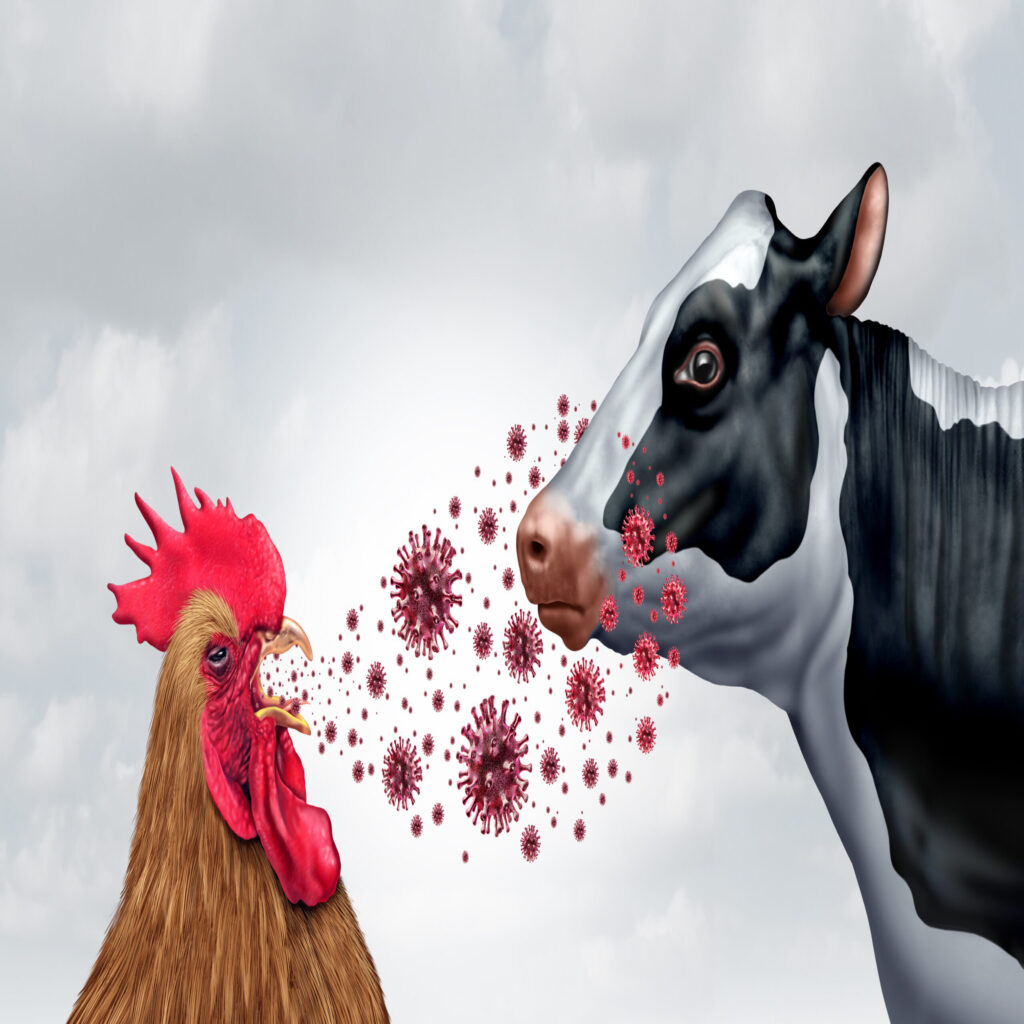Bird Flu Resurfaces
In recent years, the threat of a global pandemic caused by the avian influenza virus, commonly known as bird flu, has resurfaced. The latest strain, identified in 2025, has raised concerns among health experts and policymakers worldwide. With the potential to spread rapidly and cause severe illness in humans, the 2025 bird flu strain poses a significant public health risk.

Some History on Bird Flu
Further investigating the history of bird flu reveals that the virus has been a recurring concern since its first major outbreak in 1997. Over the years, various strains of the avian influenza virus have emerged, with some causing sporadic cases in humans and others leading to widespread outbreaks in bird populations. The constant evolution of the virus, along with its ability to jump species barriers, has kept health authorities on high alert for the possibility of a global pandemic. By taking into account this historical context, it becomes evident that ongoing monitoring and preparedness efforts are crucial in combatting the threat posed by bird flu. Read more on some of the pivotal point in history where the bird flu has impacted our understanding of it’s behavior:
- 1918 Spanish Flu Pandemic: Believed to have originated from an avian influenza virus, this pandemic caused an estimated 50-100 million deaths globally. Read more…
- 1959-1960: The first documented outbreak of highly pathogenic avian influenza (HPAI) in poultry, occurring in Scotland and the United Kingdom. Read more…
- 1996-1997: The first outbreak of H5N1 bird flu in humans, causing 18 cases and 6 deaths in Hong Kong. Read more…
- 2003-2004: A global outbreak of H5N1, affecting over 60 countries and causing over 200 human deaths. Read more…
- 2005-2006: Another large outbreak of H5N1, with cases reported in over 30 countries. Read more…
- 2013-2014: An outbreak of H7N9 bird flu in China, resulting in over 130 human cases and 45 deaths. Read more…
- 2016-2017: A global outbreak of H5N6 bird flu, with cases reported in over 30 countries.
- 2020-present: An ongoing outbreak of H5N1, which has been particularly severe in parts of Asia, Europe, and North America. Read more…
Understanding the 2025 Strain
The 2025 bird flu strain, designated as H5N1, is known for its high pathogenicity in poultry and its ability to infect humans. This particular strain has shown a worrisome combination of characteristics that make it highly transmissible among birds and, in some cases, capable of jumping to humans. The genetic makeup of the virus suggests that it could potentially mutate further, leading to increased human-to-human transmission and potentially sparking a global pandemic.
According to the Centers for Disease Control and Prevention (CDC, 2025), the bird flu has spread worldwide, infecting domesticated and wild birds, U.S. dairy cows, and several human cases. Currently, the CDC is tracking statistics within the United States, and you can find those statistics by clicking here. Please be advised, the data found in the CDC website may be potentially “skewed” due to recent executive orders from the change in administration. We advise you to due your own research and formulate your own scientific opinion.
- Dairy Cattle: Ongoing multi-state outbreak
- Wild Birds: Widespread
- Poultry Flocks: Sporadic outbreaks
- Mammals: Sporadic infections
- Person-to-person spread: None…recorded
- Person-to-person spread: Low Risk…for now
The CDC is not tracking global statistics. To keep up on the latest worldwide statistics, please visit the World Health Organization’s (WHO) website.
Global health authorities and governments have been working tirelessly to enhance preparedness measures in anticipation of a potential bird flu outbreak. Strategies include surveillance and monitoring of bird populations, rapid response protocols for outbreaks in poultry farms, stockpiling of antiviral medications, and development of vaccines specific to the 2025 strain. International cooperation and information sharing are crucial in order to contain the spread of the virus and mitigate its impact on public health.
Potential Impact on Human Health
The potential impact of the 2025 bird flu strain on human health cannot be underestimated. In past outbreaks, the virus has caused severe respiratory illness, pneumonia, and in some cases, death in infected individuals. With the 2025 strain showing signs of increased transmissibility and potential for human-to-human spread, the risk of a global pandemic looms large. Health systems around the world must be prepared to handle a surge in cases, provide adequate medical care, and implement measures to prevent further spread of the virus.
As the world braces for the potential threat of a bird flu pandemic in 2025, it is imperative that global preparedness measures are strengthened and maintained. Vigilance, cooperation, and rapid response are key in containing the spread of the virus and protecting human health. However, there may be certain political influences that may try to downplay the severity of another possible pandemic. Communities cannot and should not solely rely on their government’s response, or lack of response, to protect it’s people. You must protect yourself and you must protect your family. No one will think of you as their priority. They will be protecting the wealthy, the elite. so it is up to you and you only to prepare and protect your loved ones. We at Stay Alert Stay Alive (SASA) will keep you updated on the latest happenings and will provide additional and optional guidance, training, preparations, and mitigation measures. We will do our best to prepare an unprepared nation, for the worst case scenario.
UPDATE: Monday, February 17, 2025

CDC Suggests Human Bird-Flu Cases are Undercounted
The study published Thursday by the Centers for Disease Control and Prevention mirrors findings from two smaller studies that identified signs of infection in farmworkers who had not been previously diagnosed. While some of the farmworkers in those studies reported experiencing symptoms of H5N1 bird flu, none of the veterinarians in the new paper reported similar symptoms.
The latest study further supports the belief that the official number of confirmed human cases of bird flu in the United States, currently standing at 68 for the past year, is likely an underestimate. Dr. Gregory Gray, an infectious disease researcher at the University of Texas Medical Branch in Galveston, emphasized the need for heightened awareness and vigilance in tracking and reporting potential cases to better understand the full extent of the outbreak.
“This indicates that individuals may contract the virus through their work-related exposure but may not exhibit symptoms, leading to a lack of medical attention and diagnosis,” Gray explained. “By solely monitoring individuals who seek medical care for symptoms, we may not have a comprehensive understanding of how bird flu is being transmitted.”
Study suggests bird flu cases are undercounted
CDC researchers attended an American Association of Bovine Practitioners veterinary conference in September 2024 in Columbus, Ohio. At the conference, they engaged with 150 veterinarians from 46 states, requesting them to complete a questionnaire and consent to blood samples being collected. Surprisingly, none of the participating vets reported experiencing symptoms such as red eyes or other indicators linked to bird flu. However, subsequent testing revealed that three of the veterinarians, representing 2 percent of the sample group, exhibited evidence of antibodies associated with H5N1 infection. Interestingly, all three of the affected individuals had a history of working with dairy cattle, in addition to other animal species. Notably, none of them reported direct exposure to any herd known to be infected, although one of the vets had previous experience working with a flock of poultry that was later confirmed to be infected.
Gray and a team of researchers conducted a study in the previous year involving 14 dairy farmworkers. The study revealed that two individuals, accounting for 14 percent of the sample group, exhibited signs of past infections with the virus. Interestingly, both of these farmworkers had experienced symptoms consistent with bird flu but had never received a formal diagnosis.
Another study conducted by the CDC last year involved 115 dairy workers. The researchers discovered that eight of them, accounting for 7 percent, displayed evidence of recent infection in their blood. Half of the individuals recalled feeling unwell. While these studies were conducted on a small scale and cannot be used as a definitive estimate of undiagnosed human infections, Dr. Gray emphasized that even a minute percentage could potentially translate to hundreds or even thousands of Americans who may have been infected while working closely with animals.
“That’s not necessarily a reason to be alarmed,” said Jacqueline Nolting, an Ohio State University researcher who helped CDC with the latest study. Current studies indicate that individuals who have been infected develop antibody responses and may acquire natural immunity, which is positive news,” she added. However, if the virus were to undergo changes or mutations that lead to severe illness in individuals or easy transmission from person to person, that would present a “completely different scenario,” Nolting emphasized.
Experts urge caution around animals
The spread of the H5N1 bird flu among wild birds, poultry, cows, and other animals has been a cause for concern among officials. The increasing presence of the virus in the environment raises the likelihood of human exposure and potential infection. While the current risk to the general public is deemed low by the CDC, precautions are still advised for those who come in contact with sick or deceased birds. This includes wearing respiratory and eye protection, as well as gloves when handling poultry. Keith Poulsen, director of the Wisconsin Veterinary Diagnostic Laboratory, highlighted the need for heightened awareness and protective measures among veterinarians nationwide to prevent the spread of the virus.
UPDATE: Tuesday, February 11, 2025

Newer Strain of Bird Flu Found in Nevadan Cows
According to federal health officials, the newer strain of bird flu found in a dairy worker in Nevada differs from the version that has been spreading in U.S. herds since last year. This illness was categorized as mild, with the main symptom being eye redness and irritation, consistent with previous bird flu cases associated with dairy cows. The individual did not require hospitalization and has since fully recovered, as confirmed by the Centers for Disease Control and Prevention. This strain had been previously identified in more than a dozen individuals with exposure to poultry, but this incident marks the first documented case linked to a cow. The exposure occurred at a farm in Churchill County, situated in the west central region of the state, as reported by state health authorities.
READ MORE: Live poultry markets ordered shut for a week in New York City due to avian flu outbreak
CDC officials stated that there is no evidence suggesting that the virus has been transmitted from the affected individual to others. The agency maintains that the general public faces a low risk of contracting the virus. The current strain of bird flu, identified as Type A H5N1 influenza, has been spreading among animals and a limited number of individuals. However, scientists have identified different strains of the virus, with a specific version known as B3.13 being confirmed in March after spreading to cattle in late 2023. This particular strain has impacted 962 cattle herds across 16 states, with the highest number of cases reported in California.
READ MORE: The U.S. dodged a bird flu pandemic nearly 70 years ago. Can we do it again?
The newer strain, named D1.1, was detected in Nevada cattle on January 31. It was identified in milk samples obtained as part of a monitoring initiative that commenced in December. This discovery indicates that distinct variants of the virus have transitioned from wild birds to cattle on at least two occasions. This development raises concerns regarding the potential for wider dissemination and the challenges associated with controlling infections in animals and individuals in close contact with them. According to CDC data, at least 68 cases of bird flu have been reported in the United States in the past year. The majority of these cases involved individuals who had significant exposure to cows or poultry, with most infections attributed to the B3.13 strain. Previously, the CDC had indicated that the D1.1 variant had only been identified in cases in Louisiana and Washington state. However, recent information released by the agency suggests that the D1.1 strain likely infected a total of 15 individuals across five states – Iowa, Louisiana, Oregon, Washington, and Wisconsin – all of whom had ties to the poultry industry.
READ MORE: How bird flu puts workers on farms and in food processing plants at higher risk
The D1.1 version of the virus was linked to the first U.S. death tied to bird flu and to a severe illness in Canada. A person in Louisiana died in January after developing severe respiratory symptoms following contact with wild and backyard birds. In British Columbia, a teen girl was hospitalized for months with a virus traced to poultry. While the risk to the general public is low, the CDC says bird flu poses a greater threat to people with close or prolonged contact with infected cows, birds or other animals. Those people are encouraged to wear protective equipment and take other precautions
Updates will be provided as they come…



